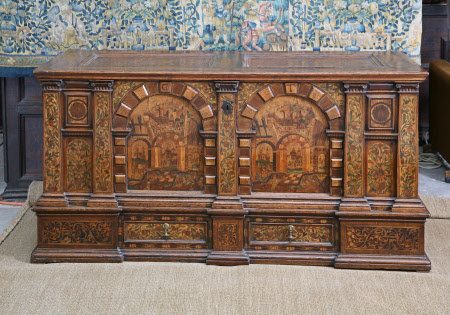Chest
Category
Furniture
Date
circa 1575
Materials
Oak carcase, marquetry and inlay of various fruitwoods and sycamore, tin-plated iron hinges and fittings, later brass drop handles
Measurements
88.5 x 175 cm
Place of origin
Germany
Order this imageCollection
Hardwick Hall, Derbyshire
NT 1127742
Summary
An oak, fruitwood and sycamore marquetry and inlaid chest, probably German, circa 1575, bearing the initials 'GT'. In very good condition, with only the lock apparently replaced. The lid of this extremely fine chest of two panels, and inlaid with 'Moresque' ornament, fitted with tinned iron hinges and enclosing a lidded till, a secret drawer below operating on a sprung wooden catch, the front of five broadening Ionic pilasters, all inlaid with floral marquetry, the two outer pairs of pilasters also flanking red roses, the central pair of panels both formed of a rusticated arch with prominent 'quoins', framing inlaid perspectives of classical ruins seen through further arches. A pair of short drawers below fitted with probably later brass drop handles and inlaid with further arabesque floral marquetry, with waist and base moulding. A border around the drawers of addorsed buds alternating with triple discs threaded on a string. The carcase and drawers of dovetailed construction.
Full description
The initials 'GT' to the keystones of the arches to this chest are believed to denote either George Talbot, 6th Earl of Shrewsbury (1528 - 1590), Bess of Hardwick's fourth husband, or his son Gilbert Talbot, 7th Earl of Shrewsbury (1552 - 1616), who married Bess' daughter, Mary, in early 1568. However, the former would have more correctly used the initials 'GS', so it is more likely that they denote Gilbert Talbot. In 1575, when he inherited Goodrich Castle, he thanked Bess for 'a greate deal of furniture'. Other known chests of this type cluster around the 1580s and 1590s. The only comparable chest in England is the Offley chest in Southwark Cathedral, made circa 1588. The date that this chest was made is unclear, but it is thought to have been made between 1568 and 1573; after the latter date there would have been no reason for the chest to come into Bess' possession. It is probable that this piece of furniture was at Chatsworth and was among the items at Chatsworth appropriated by Bess and in some cases transferred to Hardwick. Chatsworth, with several rooms lined with inlaid or marquetry paneling, would have been a more suitable home for it than the tapestry-lined rooms at Hardwick. It has been convincingly argued that this chest could relate to the 'great Inlayde Chest' recorded in Bess's Withdrawing Chamber in the Hardwick inventory of 1601. The perspectives bear a close resemblance to the plates in Hans Vredeman de Vries's Variae Architecturae Formae (Antwerp, 1562). The decoration around the drawers bears a close resemblance to the motives on an Augsburg Cabinet of the 1560s attributed to Lienhart Stromair. Although immigrant craftsmen in Southwark are known to have made inlaid furniture of this type in the later part of the 16th century, it is thought that the 'GT' chest (and the similar chest at Southwark Cathedral) were imported, probably from Germany.
Provenance
Possibly the 'great Inlayde chest' referred to in the Hardwick Hall inventory of 1601, although probably originally at Chatsworth. By descent until, following the death of Edward William Spencer Cavendish, 10th Duke of Devonshire (1895 - 1950), Hardwick Hall and its contents were accepted by HM Treasury in part payment of death duties and transferred to the National Trust, in 1959.
Marks and inscriptions
'Rural Industries Bureau' (restorer)
References
Jervis, Simon Swynfen, 'Furniture at Hardwick Hall - I' in Hardwick Hall: A Great Old Castle of Romance, eds., David Adshead and David Taylor (2016), 101 - 104 Boynton and Thornton 1971 Lindsay Boynton and Peter Thornton, ‘The Hardwick Inventories of 1601’, Journal of the Furniture History Society, Vol.VII, 1971, p. 31 and illustrated Plate 15. National Trust (Great Britain), Of household stuff: , 2001, p. 53. Bowett 2002: Adam Bowett, English Furniture 1660-1714, 2002, illustrated p. 37, Plate 2:3 & 2:4 [detail] and discussed pp. 36 - 37.
